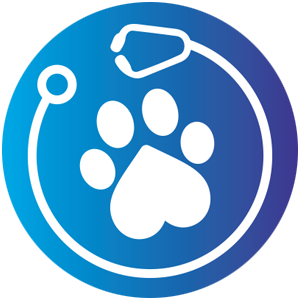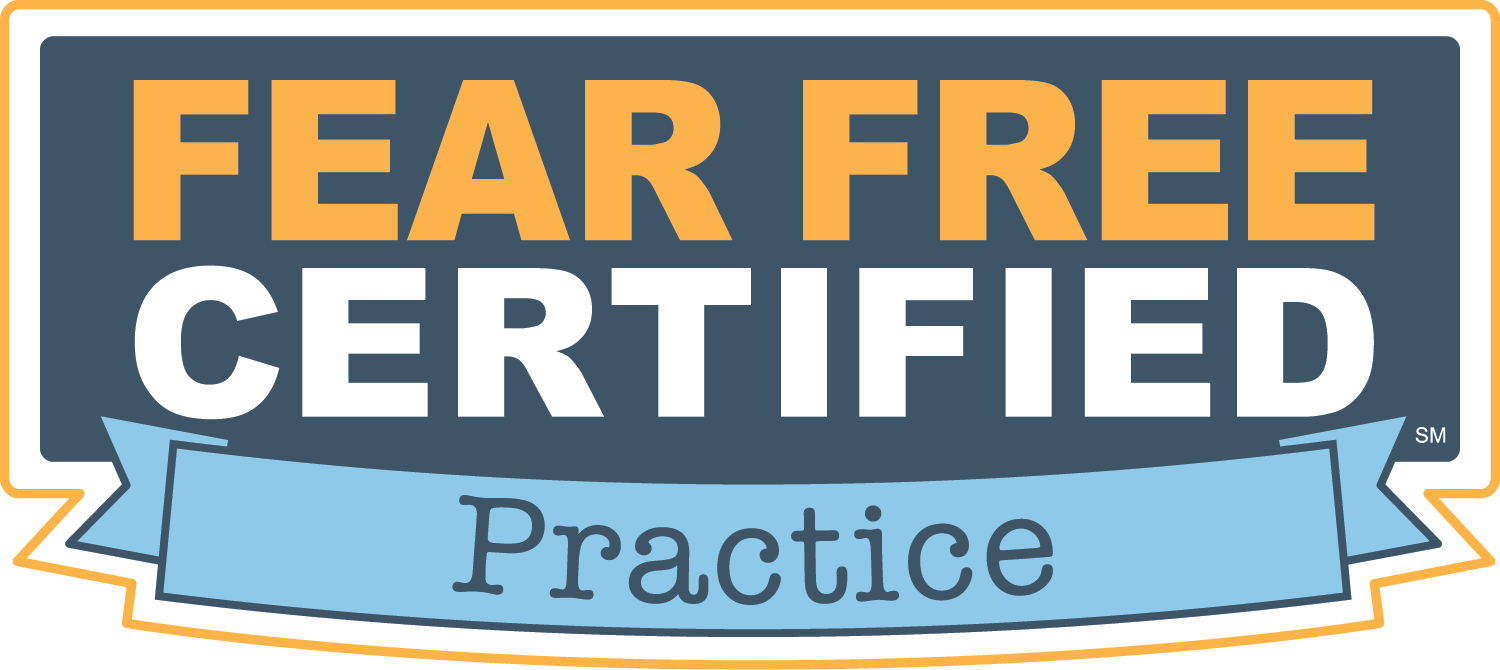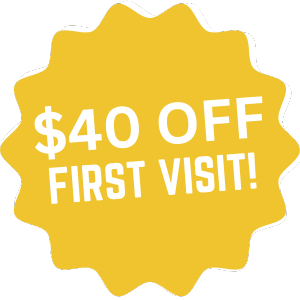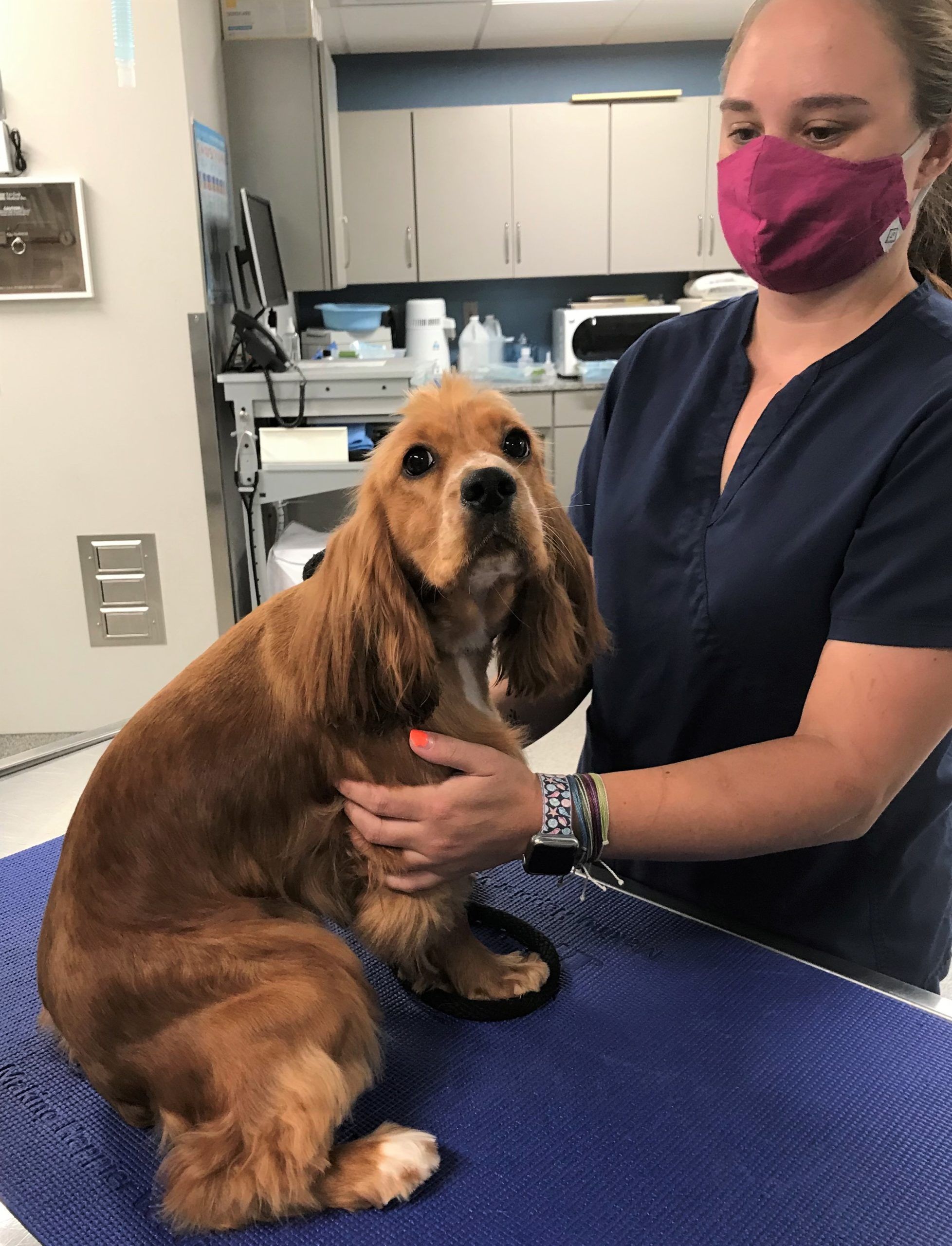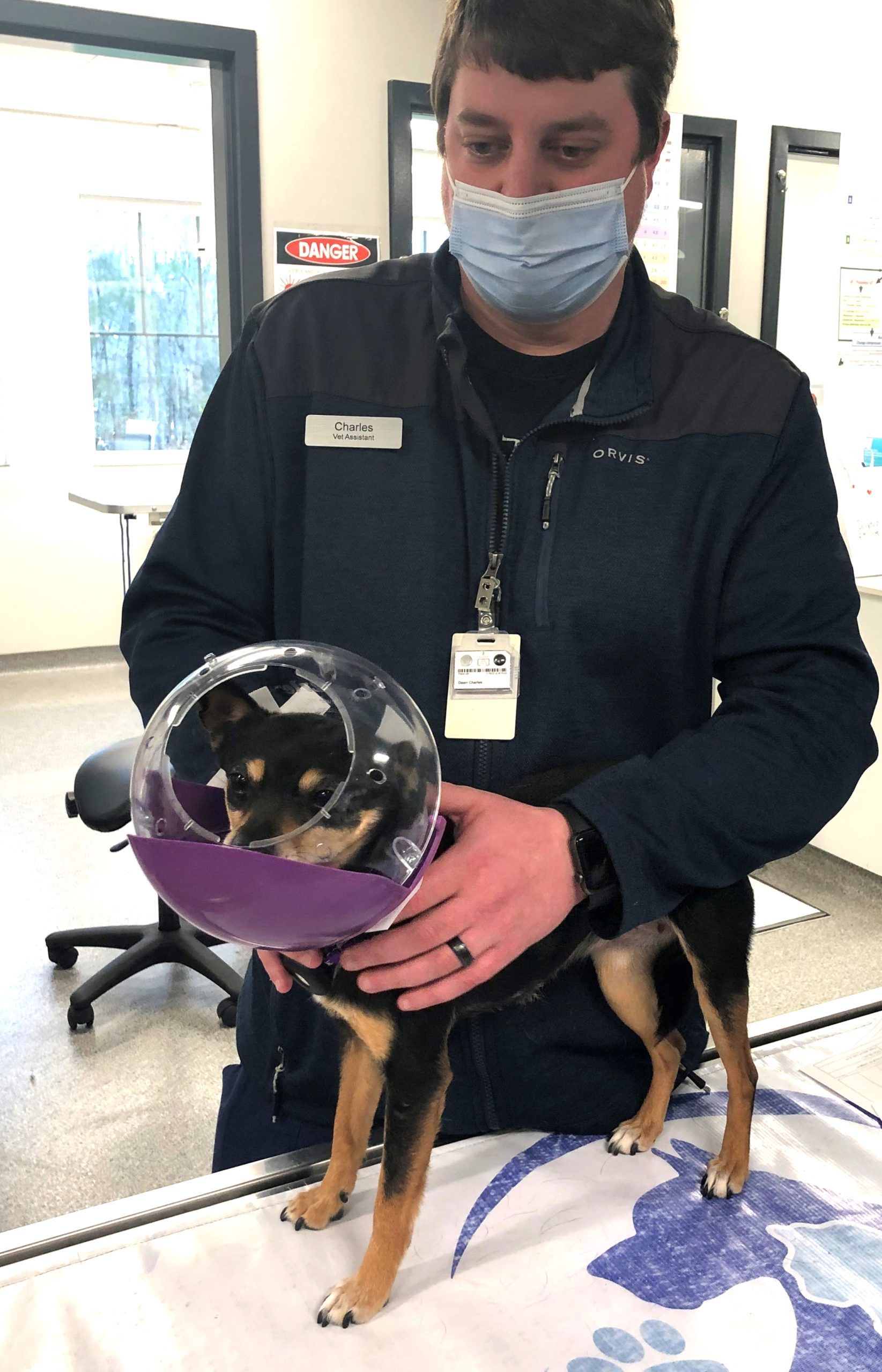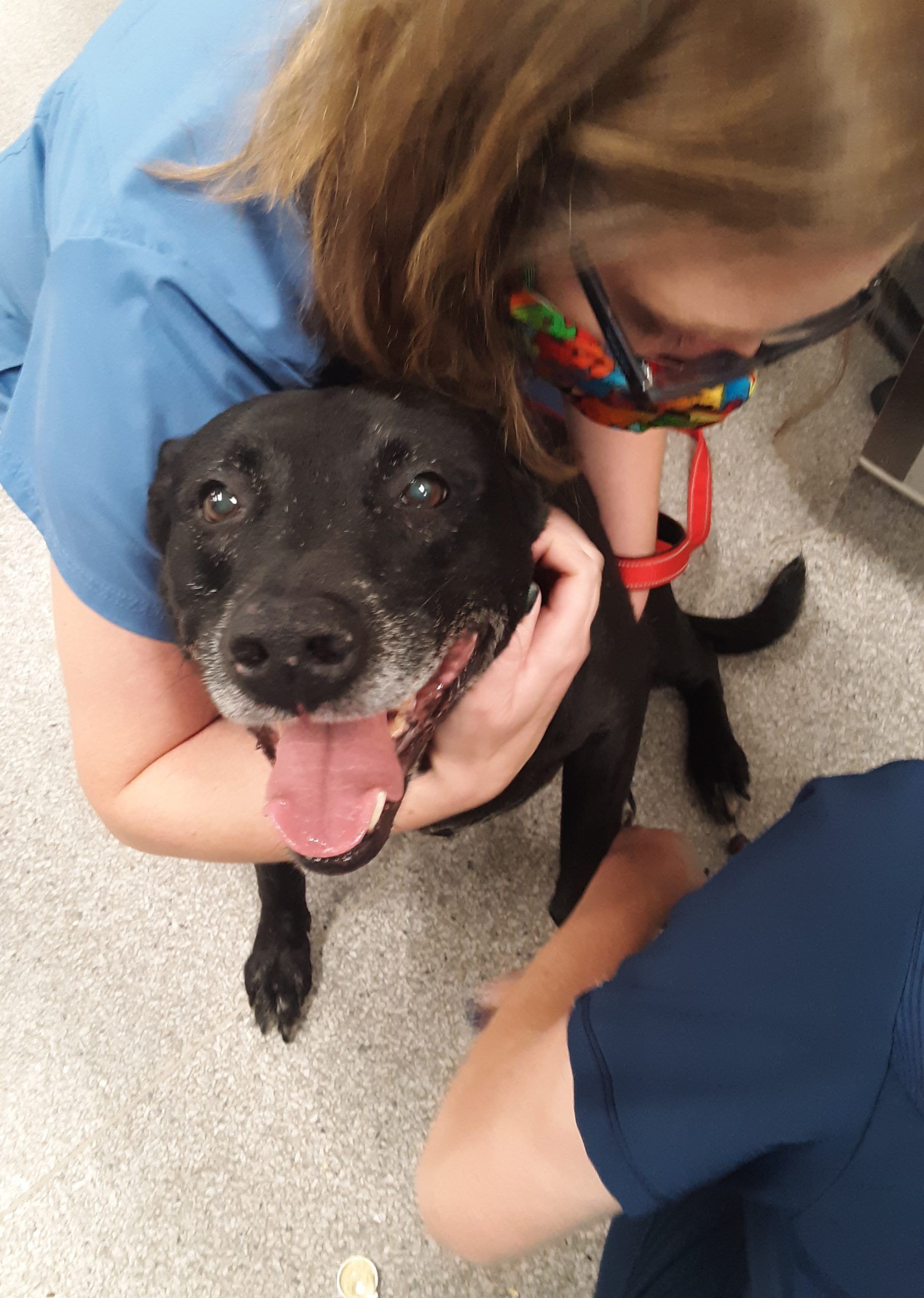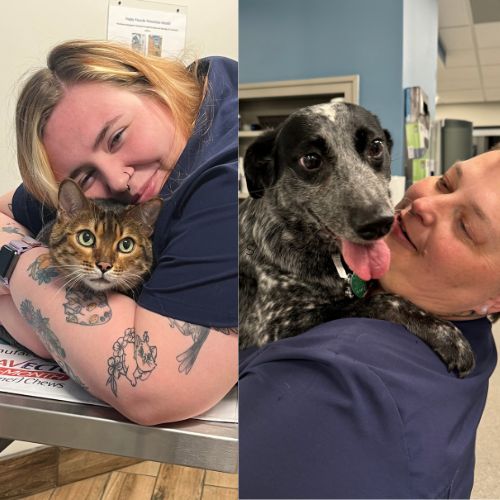
Fear Free is an official certification that denotes extensive training and credentials in preventing fear, anxiety, and stress in pets.
Every pet has unique preferences. Knowing them helps our Fear Free pros provide the best care with the least stress.
Fear Free 101
The Fear Free philosophy and its methods were developed by renowned veterinarians and pet experts, including veterinary technicians, anesthesiologists, grooming and boarding professionals, and authorities in behavior, medicine, and handling.
First and foremost, Fear Free prioritizes emotional well-being alongside physical health.
We fully endorse this beautiful concept: Pets are whole beings–with rich inner lives, emotions and preferences, concerns and worries–and deserve to be treated as such. They deserve a calm, safe, positive environment; it is our job to create it. They deserve to visit the vet without crippling anxiety or suffering trauma. Fill out a Fear Free Questionnaire for your fur baby.
Fear Free is focused on FAS…
Fear
Anxiety
Stress
We’re trained to recognize even the smallest sign of FAS and take immediate steps to stop its escalation.
While pets cannot “talk” to us, they can tell us they’re fearful, anxious, or stressed. The key is to observe, notice, and truly care. A big part of Fear Free is simply seeing what’s happening and taking positive actions.
Fear Free involves compassion, collaboration, and nurturing. For pets with higher FAS, it often involves sedation, as calming medicine is a wonderful tool to help anxious pets get the care they need. (More on this in a bit.)
Fear Free Is for Every Pet
Some pets are so perfectly happy at Eno! We’ve known them since they were babies, or they have outgoing personalities and simply love humans and attention. Some pets never worry about the physical exam, the vaccine shot, temperature taking, blood draws, or nail trims.
Fear Free methods will keep them happy! We’re committed to creating happy visits even (and especially) when a pet is not experiencing FAS.
Every Eno pet benefits from a careful approach, gentle handling, treats, praise, encouragement, and love. From the very first visit, we’re dedicated to reducing FAS or, better yet, preventing FAS from ever presenting at all.
What If My Pet Has FAS?
Many pets do, even mildly! That’s OK. (We don’t always love going to the doctor, either.)
FAS pets are not bad dogs or bad cats. It’s normal to be a little unsure at the vet. Some pets are simply hard-wired as high-strung. Some are nervous; a few are outright scared. And a very few are so terrified, frightened, and upset they become dangerous.
Each pet is unique, just like people. Fear Free includes keeping an emotional health record of any FAS right alongside your pet’s medical chart. Rest assured: We will always do and recommend what’s best for your pet.
Positive Experience = Positive Outcome
The foundation of Fear Free is positivity. We use calm, nurturing voices, so as not to excite an excitable FAS pet. We use what’s called “the considerate approach,” doing only what the pet will allow before building from there. Doing the easy stuff first helps build trust.
We reward, celebrate, and maximize positive experiences. We deploy calming pheromones for cats, called Feliway, and dogs, called Adaptil, in our exam rooms–and on our scrubs! For the ride home, we can spray this calming pheromone in your pet’s carrier or on a special towel or bandana.
Cats love our cats-only room, feather and catnip toys, and delicious treat paste. Dogs love toys, peanut butter, Cheerios, and squeezy cheese. The key is offering a wide variety of options that increase in value to the pet.
We go up the “option ladder” depending on what works best to distract and desist any FAS. That way, your pet will associate us with fun and yums and have even happier visits in the future.
Extended Care 101
If your pet is particularly anxious at vet visits, we will offer exception extended care:
- Pre-visit coordination with you
- An extensive Fear Free checklist
- A dedicated and debriefed Vet Assistant
- Visits in our Comfort Room for maximum peace and quiet
- Best practices for handling and building trust, often over time
Higher FAS Means Extended Care
For pets with higher FAS, we have myriad Fear Free methods that build trust gradually:
- Finding the right place: Pets with FAS usually do better in a quiet exam room with just one team member, a secluded corner of our Treatment Area, or even the Comfort Room. We refrain from walking a nervous pet past other pets or our people.
- Patience: Simply letting the pet take some time, when nothing is happening, to get used to the place…while taking in quiet praise and hopefully a few treats.
- Expert body positioning and language: Refraining from making eye contact right away, sitting on the floor and letting the pet come to us, making no sudden movements, and never approaching quickly or looming over a pet.
- Expert handling: We go gently. When a pet allows us that first touch, we keep one hand on the pet to offer a continuity of soft touch. We understand when less is best and always use the least handling necessary.
- Taking “no” for an answer: We will never rush or force a pet to do anything that escalates FAS. The Fear Free rule: If a cat struggles two times for more than two seconds, we stop and reassess. If a dog struggles three times for more than three seconds, we stop and reassess.
Fear Free at the Ready
Tools of Fear Free include:
- Soft towels: Some pets like to be wrapped up: a kitty or puppy burrito! The snug hold is comforting. Plus, the pet often prefers–and thus benefits from–not being able to see us at all.
- Non-slip mats: Slipping and sliding is scary; pets want solid footing. When a pet is totally OK on an exam table, we use a non-slip mat to provide security and reassurance.
- Muzzles: Did you know the right muzzle can actually help a pet calm down? If it’s what’s best for the pet, we use basket muzzles for dogs and air muzzles for cats and small dogs with short noses. These are much less constricting than cloth muzzles, plus an air muzzle also blocks the field of vision.
Needs Versus Wants
If your pet has higher FAS, your vet will talk to you about “needs versus wants.” This relates to doing the easy stuff and the crucial stuff first.
If an FAS pet needs a wellness exam, a rabies vaccine, other vaccines, a heartworm test, and a nail trim, we may decide the pet can only handle the exam and rabies vaccination that day. We want to do only what the pet will allow before FAS escalates.
Even if we only do one thing, we’ve accomplished a lot! That pet will remember if we do too much. If the visit ends before FAS escalates, a pet has experienced a positive outcome and is set up for success at the next visit.
Assessing needs versus wants is a crucial component of Fear Free. Earning each unique fur baby’s trust is essential to providing the best care. In higher FAS pets, trust is built over time, which often means several visits of extended care, often with calming medications on board.
The ‘Chill Protocol’
Each scary vet visit makes the next visit scarier. A safe, happy visit often starts at home! Fear Free calls this practice “pre-visit pharmaceuticals,” or calming medications you administer well before a visit even starts.
We often prescribe light sedatives to be given in combination both the night before and a few hours before a vet visit. These medications reduce anxiety and allow the pet to get care without suffering high FAS. A pet on the chill protocol will likely remember feeling calm, not terrified. Even still feeling a little bit nervous is better than being terrified.
Every time a pet on the chill protocol gets care, it is a big success! The chill protocol often allows us to help a pet who otherwise couldn’t have tolerated the visit at all.
Please let us know if your pet has ever experienced high FAS at the vet. We can start the chill protocol from the very beginning of our relationship with your fur baby! If your pet ever reacts with high FAS at a visit, it’s best to stop and start over at another visit with the chill protocol.
We understand you may be frustrated when we ask you to come back for another visit with your FAS pet. Yet if your pet is growing ever more fearful, anxious, or stressed even with Fear Free methods, we promise a return visit—with the chill protocol on board–really is the best course of action.
Fear Free means we must try to prevent any escalation of FAS, especially into trauma.
Delilah, when on the chill protocol, is sleepy, so she let us do an exam and update vaccines. Without the chill protocol, Delilah wouldn’t let Dr. Grinstead anywhere near her
The Trauma Is Real
In rare cases, a pet has such extreme FAS to be both in danger and a danger to others. Extreme FAS is traumatic.
Not only are we at risk of injury from an attack, the pet is injuring itself. A pet in the throes of extreme FAS is in physical duress, which causes actual trauma. The pet’s heart rate and blood pressure are at risky high levels, damaging the heart and internal systems.
If we try to get near a pet who is lunging, snarling, snapping, swiping, or hissing, we put ourselves in danger. Worse yet, if we force anything on a traumatized pet, we compound the trauma and pile on the emotional crisis. That pet will be in even more distress next time. That pet will never trust us. We’ll never be able to get anywhere near that pet again.
If your pet has extreme FAS, please don’t ask us to “just do it” or “get it over with.” As Fear Free professionals, we cannot and will not. We have a responsibility to keep both pets and people safe from harm.
The good news is Fear Free offers an extensive set of steps, including the chill protocol plus sedation at Eno, that could help your pet. If you’re willing to work with us, we’re here to help. We want to be able to see your fur baby—safely—and give the best care.
Proud to Be Fear Free
We’re ready to help all pets, but especially pets with fear, anxiety, or stress. Meet all our Fear-Free certified professionals!
We want to know all we can–about your pet’s likes and dislikes, preferences, and personality–in order to do what works best for your unique fur baby.
Please let us know how we can help. We’re all in this together!
